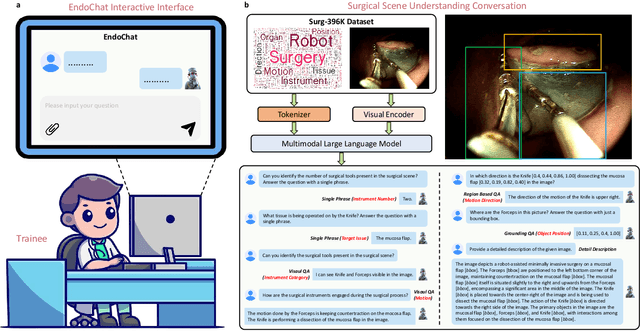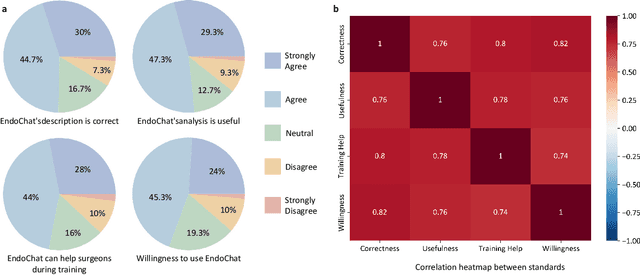Nicolas Padoy
IHU Strasbourg, UNISTRA
CoSimGen: Controllable Diffusion Model for Simultaneous Image and Mask Generation
Mar 25, 2025Abstract:The acquisition of annotated datasets with paired images and segmentation masks is a critical challenge in domains such as medical imaging, remote sensing, and computer vision. Manual annotation demands significant resources, faces ethical constraints, and depends heavily on domain expertise. Existing generative models often target single-modality outputs, either images or segmentation masks, failing to address the need for high-quality, simultaneous image-mask generation. Additionally, these models frequently lack adaptable conditioning mechanisms, restricting control over the generated outputs and limiting their applicability for dataset augmentation and rare scenario simulation. We propose CoSimGen, a diffusion-based framework for controllable simultaneous image and mask generation. Conditioning is intuitively achieved through (1) text prompts grounded in class semantics, (2) spatial embedding of context prompts to provide spatial coherence, and (3) spectral embedding of timestep information to model noise levels during diffusion. To enhance controllability and training efficiency, the framework incorporates contrastive triplet loss between text and class embeddings, alongside diffusion and adversarial losses. Initial low-resolution outputs 128 x 128 are super-resolved to 512 x 512, producing high-fidelity images and masks with strict adherence to conditions. We evaluate CoSimGen on metrics such as FID, KID, LPIPS, Class FID, Positive predicted value for image fidelity and semantic alignment of generated samples over 4 diverse datasets. CoSimGen achieves state-of-the-art performance across all datasets, achieving the lowest KID of 0.11 and LPIPS of 0.53 across datasets.
fine-CLIP: Enhancing Zero-Shot Fine-Grained Surgical Action Recognition with Vision-Language Models
Mar 25, 2025Abstract:While vision-language models like CLIP have advanced zero-shot surgical phase recognition, they struggle with fine-grained surgical activities, especially action triplets. This limitation arises because current CLIP formulations rely on global image features, which overlook the fine-grained semantics and contextual details crucial for complex tasks like zero-shot triplet recognition. Furthermore, these models do not explore the hierarchical structure inherent in triplets, reducing their ability to generalize to novel triplets. To address these challenges, we propose fine-CLIP, which learns object-centric features and lever- ages the hierarchy in triplet formulation. Our approach integrates three components: hierarchical prompt modeling to capture shared semantics, LoRA-based vision backbone adaptation for enhanced feature extraction, and a graph-based condensation strategy that groups similar patch features into meaningful object clusters. Since triplet classification is a challenging task, we introduce an alternative yet meaningful base-to-novel generalization benchmark with two settings on the CholecT50 dataset: Unseen-Target, assessing adaptability to triplets with novel anatomical structures, and Unseen-Instrument-Verb, where models need to generalize to novel instrument-verb interactions. fine-CLIP shows significant improvements in F1 and mAP, enhancing zero-shot recognition of novel surgical triplets.
Learning from Synchronization: Self-Supervised Uncalibrated Multi-View Person Association in Challenging Scenes
Mar 17, 2025Abstract:Multi-view person association is a fundamental step towards multi-view analysis of human activities. Although the person re-identification features have been proven effective, they become unreliable in challenging scenes where persons share similar appearances. Therefore, cross-view geometric constraints are required for a more robust association. However, most existing approaches are either fully-supervised using ground-truth identity labels or require calibrated camera parameters that are hard to obtain. In this work, we investigate the potential of learning from synchronization, and propose a self-supervised uncalibrated multi-view person association approach, Self-MVA, without using any annotations. Specifically, we propose a self-supervised learning framework, consisting of an encoder-decoder model and a self-supervised pretext task, cross-view image synchronization, which aims to distinguish whether two images from different views are captured at the same time. The model encodes each person's unified geometric and appearance features, and we train it by utilizing synchronization labels for supervision after applying Hungarian matching to bridge the gap between instance-wise and image-wise distances. To further reduce the solution space, we propose two types of self-supervised linear constraints: multi-view re-projection and pairwise edge association. Extensive experiments on three challenging public benchmark datasets (WILDTRACK, MVOR, and SOLDIERS) show that our approach achieves state-of-the-art results, surpassing existing unsupervised and fully-supervised approaches. Code is available at https://github.com/CAMMA-public/Self-MVA.
S4M: Segment Anything with 4 Extreme Points
Mar 07, 2025Abstract:The Segment Anything Model (SAM) has revolutionized open-set interactive image segmentation, inspiring numerous adapters for the medical domain. However, SAM primarily relies on sparse prompts such as point or bounding box, which may be suboptimal for fine-grained instance segmentation, particularly in endoscopic imagery, where precise localization is critical and existing prompts struggle to capture object boundaries effectively. To address this, we introduce S4M (Segment Anything with 4 Extreme Points), which augments SAM by leveraging extreme points -- the top-, bottom-, left-, and right-most points of an instance -- prompts. These points are intuitive to identify and provide a faster, structured alternative to box prompts. However, a na\"ive use of extreme points degrades performance, due to SAM's inability to interpret their semantic roles. To resolve this, we introduce dedicated learnable embeddings, enabling the model to distinguish extreme points from generic free-form points and better reason about their spatial relationships. We further propose an auxiliary training task through the Canvas module, which operates solely on prompts -- without vision input -- to predict a coarse instance mask. This encourages the model to internalize the relationship between extreme points and mask distributions, leading to more robust segmentation. S4M outperforms other SAM-based approaches on three endoscopic surgical datasets, demonstrating its effectiveness in complex scenarios. Finally, we validate our approach through a human annotation study on surgical endoscopic videos, confirming that extreme points are faster to acquire than bounding boxes.
Multi-view Video-Pose Pretraining for Operating Room Surgical Activity Recognition
Feb 19, 2025



Abstract:Understanding the workflow of surgical procedures in complex operating rooms requires a deep understanding of the interactions between clinicians and their environment. Surgical activity recognition (SAR) is a key computer vision task that detects activities or phases from multi-view camera recordings. Existing SAR models often fail to account for fine-grained clinician movements and multi-view knowledge, or they require calibrated multi-view camera setups and advanced point-cloud processing to obtain better results. In this work, we propose a novel calibration-free multi-view multi-modal pretraining framework called Multiview Pretraining for Video-Pose Surgical Activity Recognition PreViPS, which aligns 2D pose and vision embeddings across camera views. Our model follows CLIP-style dual-encoder architecture: one encoder processes visual features, while the other encodes human pose embeddings. To handle the continuous 2D human pose coordinates, we introduce a tokenized discrete representation to convert the continuous 2D pose coordinates into discrete pose embeddings, thereby enabling efficient integration within the dual-encoder framework. To bridge the gap between these two modalities, we propose several pretraining objectives using cross- and in-modality geometric constraints within the embedding space and incorporating masked pose token prediction strategy to enhance representation learning. Extensive experiments and ablation studies demonstrate improvements over the strong baselines, while data-efficiency experiments on two distinct operating room datasets further highlight the effectiveness of our approach. We highlight the benefits of our approach for surgical activity recognition in both multi-view and single-view settings, showcasing its practical applicability in complex surgical environments. Code will be made available at: https://github.com/CAMMA-public/PreViPS.
When do they StOP?: A First Step Towards Automatically Identifying Team Communication in the Operating Room
Feb 12, 2025Abstract:Purpose: Surgical performance depends not only on surgeons' technical skills but also on team communication within and across the different professional groups present during the operation. Therefore, automatically identifying team communication in the OR is crucial for patient safety and advances in the development of computer-assisted surgical workflow analysis and intra-operative support systems. To take the first step, we propose a new task of detecting communication briefings involving all OR team members, i.e. the team Time-out and the StOP?-protocol, by localizing their start and end times in video recordings of surgical operations. Methods: We generate an OR dataset of real surgeries, called Team-OR, with more than one hundred hours of surgical videos captured by the multi-view camera system in the OR. The dataset contains temporal annotations of 33 Time-out and 22 StOP?-protocol activities in total. We then propose a novel group activity detection approach, where we encode both scene context and action features, and use an efficient neural network model to output the results. Results: The experimental results on the Team-OR dataset show that our approach outperforms existing state-of-the-art temporal action detection approaches. It also demonstrates the lack of research on group activities in the OR, proving the significance of our dataset. Conclusion: We investigate the Team Time-Out and the StOP?-protocol in the OR, by presenting the first OR dataset with temporal annotations of group activities protocols, and introducing a novel group activity detection approach that outperforms existing approaches. Code is available at https://github.com/CAMMA-public/Team-OR .
Early Operative Difficulty Assessment in Laparoscopic Cholecystectomy via Snapshot-Centric Video Analysis
Feb 10, 2025Abstract:Purpose: Laparoscopic cholecystectomy (LC) operative difficulty (LCOD) is highly variable and influences outcomes. Despite extensive LC studies in surgical workflow analysis, limited efforts explore LCOD using intraoperative video data. Early recog- nition of LCOD could allow prompt review by expert surgeons, enhance operating room (OR) planning, and improve surgical outcomes. Methods: We propose the clinical task of early LCOD assessment using limited video observations. We design SurgPrOD, a deep learning model to assess LCOD by analyzing features from global and local temporal resolutions (snapshots) of the observed LC video. Also, we propose a novel snapshot-centric attention (SCA) module, acting across snapshots, to enhance LCOD prediction. We introduce the CholeScore dataset, featuring video-level LCOD labels to validate our method. Results: We evaluate SurgPrOD on 3 LCOD assessment scales in the CholeScore dataset. On our new metric assessing early and stable correct predictions, SurgPrOD surpasses baselines by at least 0.22 points. SurgPrOD improves over baselines by at least 9 and 5 percentage points in F1 score and top1-accuracy, respectively, demonstrating its effectiveness in correct predictions. Conclusion: We propose a new task for early LCOD assessment and a novel model, SurgPrOD analyzing surgical video from global and local perspectives. Our results on the CholeScore dataset establishes a new benchmark to study LCOD using intraoperative video data.
Medical Multimodal Model Stealing Attacks via Adversarial Domain Alignment
Feb 04, 2025Abstract:Medical multimodal large language models (MLLMs) are becoming an instrumental part of healthcare systems, assisting medical personnel with decision making and results analysis. Models for radiology report generation are able to interpret medical imagery, thus reducing the workload of radiologists. As medical data is scarce and protected by privacy regulations, medical MLLMs represent valuable intellectual property. However, these assets are potentially vulnerable to model stealing, where attackers aim to replicate their functionality via black-box access. So far, model stealing for the medical domain has focused on classification; however, existing attacks are not effective against MLLMs. In this paper, we introduce Adversarial Domain Alignment (ADA-STEAL), the first stealing attack against medical MLLMs. ADA-STEAL relies on natural images, which are public and widely available, as opposed to their medical counterparts. We show that data augmentation with adversarial noise is sufficient to overcome the data distribution gap between natural images and the domain-specific distribution of the victim MLLM. Experiments on the IU X-RAY and MIMIC-CXR radiology datasets demonstrate that Adversarial Domain Alignment enables attackers to steal the medical MLLM without any access to medical data.
EndoChat: Grounded Multimodal Large Language Model for Endoscopic Surgery
Jan 20, 2025



Abstract:Recently, Multimodal Large Language Models (MLLMs) have demonstrated their immense potential in computer-aided diagnosis and decision-making. In the context of robotic-assisted surgery, MLLMs can serve as effective tools for surgical training and guidance. However, there is still a lack of MLLMs specialized for surgical scene understanding in clinical applications. In this work, we introduce EndoChat to address various dialogue paradigms and subtasks in surgical scene understanding that surgeons encounter. To train our EndoChat, we construct the Surg-396K dataset through a novel pipeline that systematically extracts surgical information and generates structured annotations based on collected large-scale endoscopic surgery datasets. Furthermore, we introduce a multi-scale visual token interaction mechanism and a visual contrast-based reasoning mechanism to enhance the model's representation learning and reasoning capabilities. Our model achieves state-of-the-art performance across five dialogue paradigms and eight surgical scene understanding tasks. Additionally, we conduct evaluations with professional surgeons, most of whom provide positive feedback on collaborating with EndoChat. Overall, these results demonstrate that our EndoChat has great potential to significantly advance training and automation in robotic-assisted surgery.
Text-driven Adaptation of Foundation Models for Few-shot Surgical Workflow Analysis
Jan 16, 2025Abstract:Purpose: Surgical workflow analysis is crucial for improving surgical efficiency and safety. However, previous studies rely heavily on large-scale annotated datasets, posing challenges in cost, scalability, and reliance on expert annotations. To address this, we propose Surg-FTDA (Few-shot Text-driven Adaptation), designed to handle various surgical workflow analysis tasks with minimal paired image-label data. Methods: Our approach has two key components. First, Few-shot selection-based modality alignment selects a small subset of images and aligns their embeddings with text embeddings from the downstream task, bridging the modality gap. Second, Text-driven adaptation leverages only text data to train a decoder, eliminating the need for paired image-text data. This decoder is then applied to aligned image embeddings, enabling image-related tasks without explicit image-text pairs. Results: We evaluate our approach to generative tasks (image captioning) and discriminative tasks (triplet recognition and phase recognition). Results show that Surg-FTDA outperforms baselines and generalizes well across downstream tasks. Conclusion: We propose a text-driven adaptation approach that mitigates the modality gap and handles multiple downstream tasks in surgical workflow analysis, with minimal reliance on large annotated datasets. The code and dataset will be released in https://github.com/TingxuanSix/Surg-FTDA.
 Add to Chrome
Add to Chrome Add to Firefox
Add to Firefox Add to Edge
Add to Edge